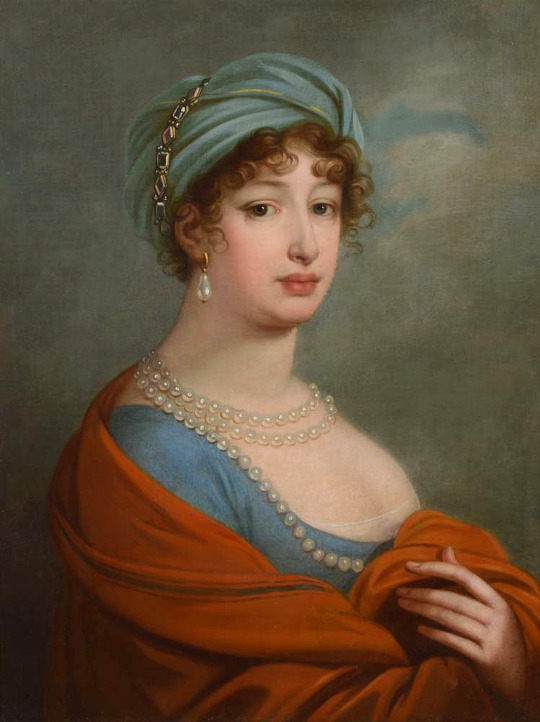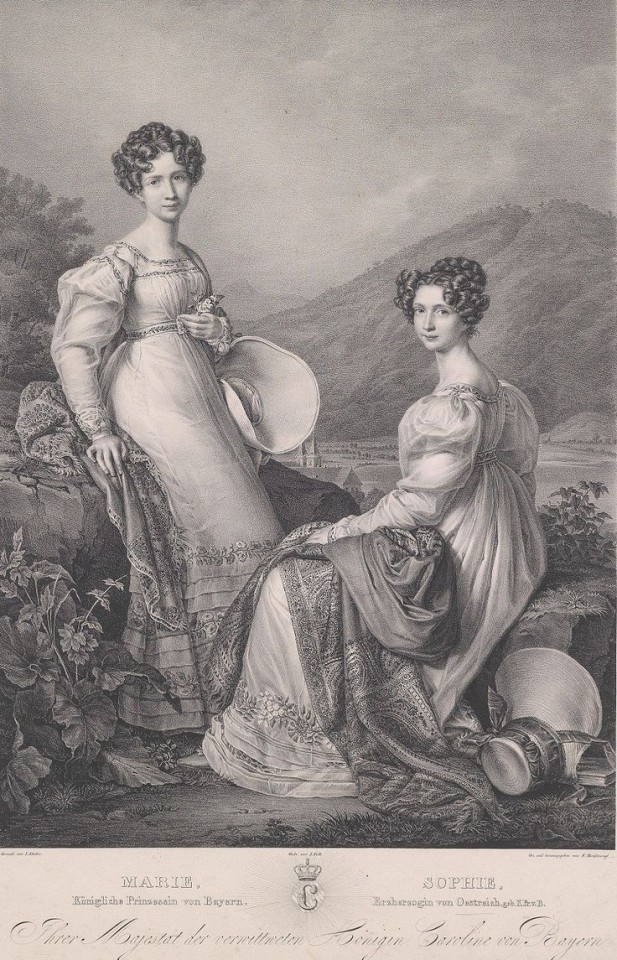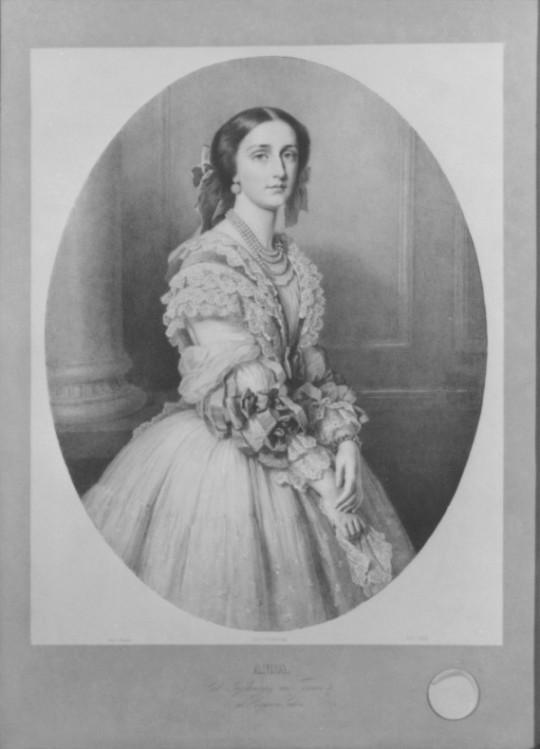#House Wettin
Explore tagged Tumblr posts
Text

Regina von Habsburg (6 January 1925 – 3 February 2010), also known by the traditional royal title of Archduchess Regina of Austria, was a German-born Austrian social worker. She was a member of the House of Wettin by birth and married to Otto von Habsburg, the last heir of the Austro-Hungarian Empire.
#Regina von Habsburg#House Wettin#xx century#xxi century#women in history#photo#photography#black and white
0 notes
Text

Portrait of Princess Karoline Amalie of Hesse-Kassel (1771-1848), second wife of Augustus, Duke of Saxe-Coburg-Gotha-Altenburg. By Josef Grassi and Ludwig Döll.
#josef grassi#ludwig döll#haus wettin#house of saxe coburg and gotha#german aristocracy#haus hessen#hessen altenburg#royalty#german empire
94 notes
·
View notes
Text






Someone on the Internet once called Maria Amalia of Saxony, Queen of Spain, Sicily and Naples, and her husband, Charles III of Spain, “the ugliest royal couple of their time”. An though I must admit that Charles III was more known for his wits than his looks, being rejected later in life by princess Marie Adélaïde of France for his portrait, Maria Amalia seemed to be a graceful young woman, but most likely grew weary and older-looking than her age with the time; giving birth to thirteen children in twenty two years, five of whom died when she was still alive, must have made her look older and frailer in her later paintings.
Honestly, that discourse is yet another “not a great beauty” comment on historical women, and I hate it.
#Maria Amalia of Saxony#Queen of Spain#Queen of Naples#Queen of Sicily#House of Bourbon#House of Wettin
14 notes
·
View notes
Text

Maria Anna Sophia of Saxony, Electress of Bavaria.
#Maria Anna Sophia of Saxony#electress of bavaria#18th century#18th century art#house of wettin#long live the queue
44 notes
·
View notes
Text

Empress Carlota of Mexico
Artist: Santiago Rebull (Mexico, 1829–1902)
Date: 1867
Medium: Oil on Canvas
Collection: Instituto Nacional de Bellas Artes y Literatura, Mexico City, Mexico
Empress Carlota of Mexico
Charlotte of Belgium (French: Marie Charlotte Amélie Augustine Victoire Clémentine Léopoldine; 7 June 1840 – 19 January 1927), known by the Spanish version of her name, Carlota, was by birth a princess of Belgium and member of the House of Wettin in the branch of Saxe-Coburg and Gotha (as such she was also styled Princess of Saxe-Coburg and Gotha and Duchess in Saxony). As the wife of Archduke Maximilian of Austria, Viceroy of Lombardy-Venetia and later Emperor of Mexico, she became Archduchess of Austria (in 1857) and Empress of Mexico (in 1864). She was daughter, granddaughter, sister, sister in-law, cousin and wife of reigning or deposed sovereigns throughout Europe and Mexico.
#portrait#painting#empress carlota of mexico#half length#white dress#red sash#pearl necklace#mexican culture#mexican history#mexican empress#crown#pearl earrings#tiara#mexican art#house of wettin#charlotte of belgium#history portrait#santiago rebull#mexican painter#historical art#19th century painting
8 notes
·
View notes
Text

Ernest II (1818-1893) duke of Saxe-Coburg and Gotha. By Frederick Richard Say.
He was the older brother of Prince Albert, the husband of Queen Victoria.
#Frederick Richard Say#Herzog von Sachsen-Coburg und Gotha#haus wettin#german aristocracy#house of wettin#house of saxe coburg and gotha#ernst ii
6 notes
·
View notes
Text

Archduchess Sophie of Austria - Hungary with her identical twin sister Princess Maria Anna of Bavaria, future Queen of Saxony.
#archduchess sophie of austria#queen maria anna of saxony#austrian imperial family#saxon royalty#austrian history#german history#house of habsburg#house of wettin
42 notes
·
View notes
Text

“i think wettin should have remained kings of poland” - Submitted by Anonymous
9 notes
·
View notes
Note
Hi! Can you write about Princess Anna of Saxony, Hereditary Grand Duchess of Tuscany?
Hi! I don't know much about her since there isn't a lot of information available.

Born on 4 January, 1836, she was the seventh child of King Johann I of Saxony and Princess Amalie of Bavaria. She married on 1856, 24 November, to the heir of Tuscany, later last Grand Duke Ferdinando IV (two of her elder sisters, Marie and Sidonie, were still single at the time - another exemple of sisters not marrying always by order of birth). They had one child, Maria Antonietta, born 10 January, 1858. Anna died a little over year later, on 10 February, 1859, due to a miscarriage result of typhoid fever. She was 23 years old; in this she joined her sisters: with the exception of Elisabeth, who died aged 82, all of the daughters of Johann and Amalie died between the ages of 18 and 30 due to illness. Her daughter sadly also died young, at only 25 years old (I can't find what exactly she died of, only that she had a "delicate health").
#according to wikipedia there were rumors that maria antonietta and rudolf hooked up? i'll look into that#anna of saxony hereditary grand duchess of tuscany#house of wettin#asks
6 notes
·
View notes
Photo

#761105851989753856/kWMZSDkL#Sir Cecil Beaton#House of Wettin#Elizabeth II#United Kingdom#2022#September 8th#portraits#photographs
0 notes
Text

The staircase in Dresden Castle,
Built in the 18th century
Dresden Castle or Royal Palace (German: Dresdner Residenzschloss or Dresdner Schloss) is one of the oldest buildings in Dresden, Germany. For almost 400 years, it was the residence of the electors (1547–1806) and kings (1806–1918) of Saxony from the Albertine House of Wettin as well as Kings of Poland (1697–1763). It is known for the different architectural styles employed, from Baroque to Neo-renaissance.
2 notes
·
View notes
Text
HEATHEN DISCO ep. 335 streaming now

HOUR 1
Mark – For Your Own Personal Ends
Cymande – Dove
Vaughan Mason & Crew – Bounce, Rock, Skate, Roll Pt. 2
Natural Information Society – Immemorial
Invisible Man’s Band – Rent Strike
Jane Inc. – 2120
Astaron – St. John’s Fire
Total Control – Paranoid Video
Chasms – Parallel
Rob Mazurek / Exploding Star Orchestra – White River
Ron Morelli – Tangled Trap of Love
HOUR 2
Curve – Coast Is Clear
DAF – El Que
The Flowerpot Men – Beat City
Bastro – Recidivist
Access Denied – No Way Back
The Good Samaritans – Gaskya-Kace
Shawn Maxwell – Appointment with…
Invisible Man’s Band – All Night Thing
City Boy – 5.7.0.5
Guy – Spend the Night
Tristan Disco – Social Dance (Krikor Remix)
Maurice Poto Doudongo – Passport Train
Shudder to Think – X-French Tee Shirt
Fire-Toolz – Paraclete Bhishajyati
Jana Horn – In Between
HOUR 3
Cherubs – Dreamin’
Connections - Lorraine
The Sundays – A Certain Someone
Morgan and the Organ Donors – So Dark
Hard Stuff – Jay Time
Cherokee – Girl, I’ve Got News For You
Dust – Chasin’ Ladies
Rock Island – I Keep on Tryin’
Sir Lord Baltimore – Lady of Fire
Crabby Appleton – Go Back
KVL – Absent Crash
Budgie – Breadfan
The Gun Club – Sex Beat
Bed Wettin’ Bad Boys – Nobody Else
Television Personalities – This Angry Silence
Lloyd Cole and the Commotions – My Bag
HOUSE of ALL – Dominus Rumine
5 notes
·
View notes
Text

Prince Leopold of Saxe-Coburg and Gotha-Koháry (1824-1884). Unknown artist.
He was considered as the English government's candidate to be the husband of Queen Isabella II of Spain. This candidacy was due to the UK's strong ties with the House of Saxe-Coburg-Gotha. The candidate was a first cousin of Queen Victoria's husband Albert, a nephew of King Leopold of Belgium, and a first cousin of King Ferdinand II of Portugal married to Queen Maria II.
#prince leopold of saxe coburg and gotha kohary#haus wettin#german aristocracy#house of saxe coburg and gotha#house of saxe coburg and gotha kohary#blond guys#pornstache#royalty
22 notes
·
View notes
Text

Don Carlos Antonio de Borbón y Sajonia, XXVIIIº Príncipe de Asturias e Infante de España, by Anton Raphael Mengs.
2 notes
·
View notes
Text
Cant believe im joining this.
But where is Henry VIII in this list? And then Elizabeth the first his second born daughter to Anne Bolyn who famously said "It would please me best if, at the last a marble stone shall record that this Queen having lived such and such a time lived and died a virgin"
Reminder she died in 1603 and James the VI of Scotland took over. Who become James the first of england who was the son of Mary queen of scots, Elizabeth the firsts rival. Now the house of stuarts was a Scottish family, that started in 1371 by the King Robert II of Scotland. And granted, James IV married Margaret Tudor in 1503 linking the Tudor family with the Stuarts.
You seem to be omitting several kings and queens of england to try and prove your point. Now there is no solid scientific proof that all kings and queens were related to William the conqueror. Now granted they may have had a connection or tried to claim they were related. Plus, we do not know if any child was swapped with another because accidents, illness, assassinations. Such as the famous conspiracy theory with Queen Elizabeth I. It is called the bisley boy conspiracy.
Let us not forgot that our current UK monarchy is german. They genealogically belong to house of oldenburg as the late Prince Philip was a member of the Glücksburg branch.
Even more details
House of Windsor is the cadet branch to the House of Saxe-Coburg and Gotha which is a European royal house whose parent house is House of Wettin which is a Dynasty of german kings, princes, dukes and counts.
House of Wettin is one of the oldest dynasties in europe. And this house cant be traced to William the conqueror.
Henry VII started the tudor reign and took the throne in 1485 after Richard III died in battle (Still cant believe we found his body under a bloody car park)
Here is a family tree from The Plantagenets by Dan Jones


Now if we want to get technical, the United Kingdom of Great Britain and Ireland didn't become a kingdom until ireland joined in 1801, then in 1920 it become United Kingdom of Great Britain and Northern Ireland.
It is well known that there has been several wars between England and Scotland. They had a political union in 1707, under Queen Anne, this time having same everything, not just a shared king/queen but shared parliament and such.
Now the Monarchy of England its self started in the year 927 with Æthelstan and ended with Queen Anne in 1707
So really there is no English Monarchy.
There is a United kingdom of Great Britain (England, Wales and Scotland) and Northern Ireland Monarchy.
Okay, here's my idea:
The British should put a time limit on the Monarchy.
Not like declaring a republic tomorrow, but deciding on a date in the future that ends the British Monarchy.
And there's a perfect date for it coming up!
October 14th, 2066.
A thousand years since the Battle of Hastings. A thousand years of this one specific bloodline ruling England.
Call time on the Monarchy after exactly one thousand years. Nice, and neat.
Even better: Charles isn't living 44 years. He'll be gone in about twenty. Now William? He's what, 40? Yeah, he can live another 44 years. His great grandmother was over a hundred, his granny was 96, William can make it to 84 barring accident or assassination.
So on October 14th 2066, William the Last steps down a thousand years after William the First won the crown.
Nice, neat, and fair. William gets the crown he's been waiting forty years for already, but ten-year-old George grows up without expectation of it.
Have a nice big abdication ceremony, even.
107K notes
·
View notes
Text

Augustus the Strong, Elector of Saxony and King of Poland
Artist: Nicolas de Largillierre (French, 1656-1746)
Date:ca. 1715
Medium: Oil on canvas
Collection: The Nelson-Atkins Museum of Art, Kansas City, Missouri, United States
Augustus II the Strong
Augustus II the Strong (12 May 1670 – 1 February 1733), was Elector of Saxony from 1694 as well as King of Poland and Grand Duke of Lithuania from 1697 to 1706 and from 1709 until his death in 1733. He belonged to the Albertine branch of the House of Wettin.
#portrait#polish king#oil on canvas#painting#augustus ii the strong#artwork#fine art#oil painting#elector of saxony#grand duke of lithuania#house of wetlin#knee length#armor#curly hair#fur trimmed cape#emerald#blue moire sash#order of the elephant#lace cuffs#lace collar#ruby clasp#sword hilt#ruby pommel#burning town#holy roman empire#polish history#french culture#french art#nicolas de largillière#french painter
28 notes
·
View notes